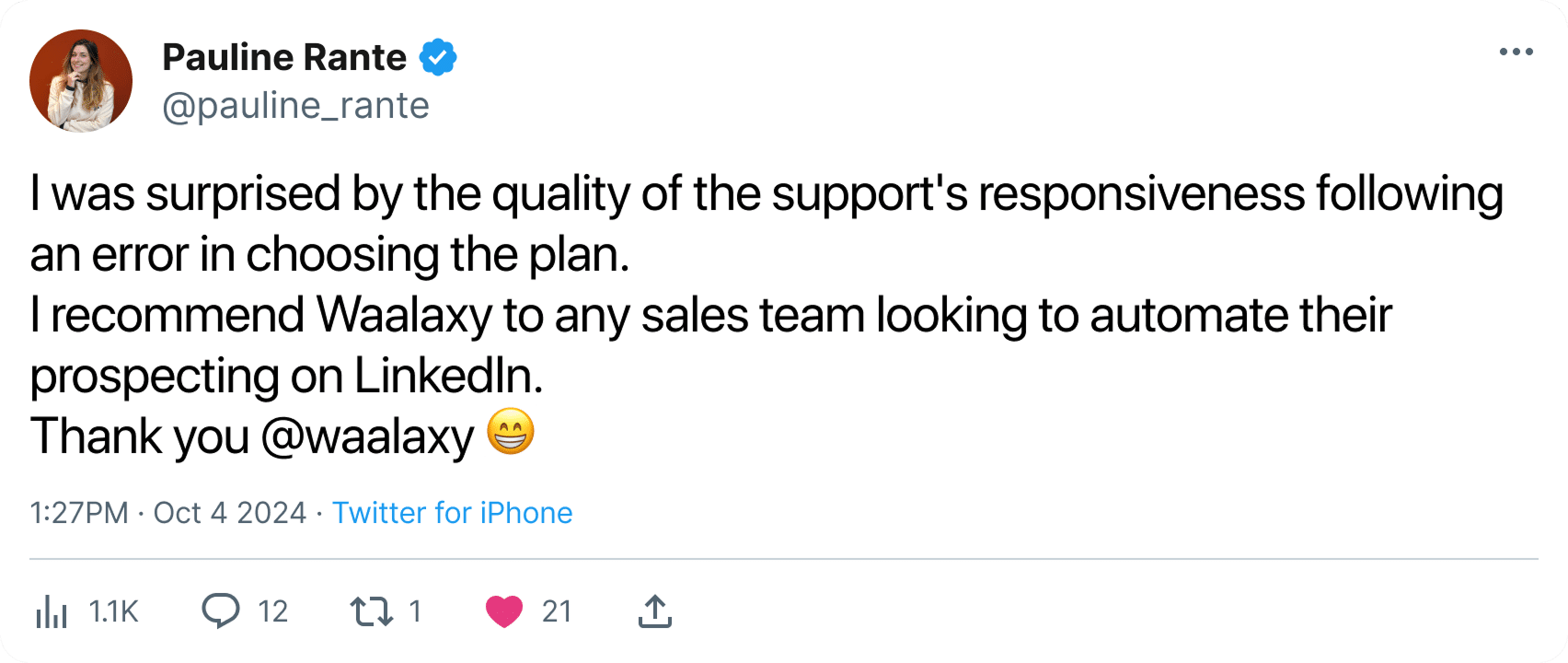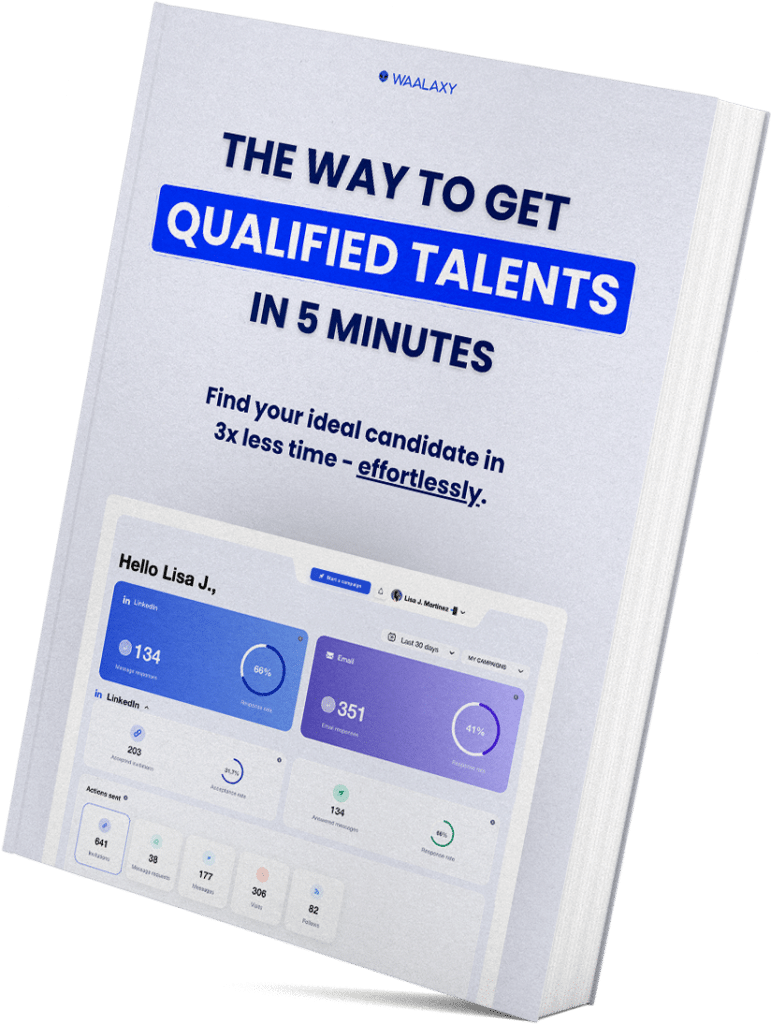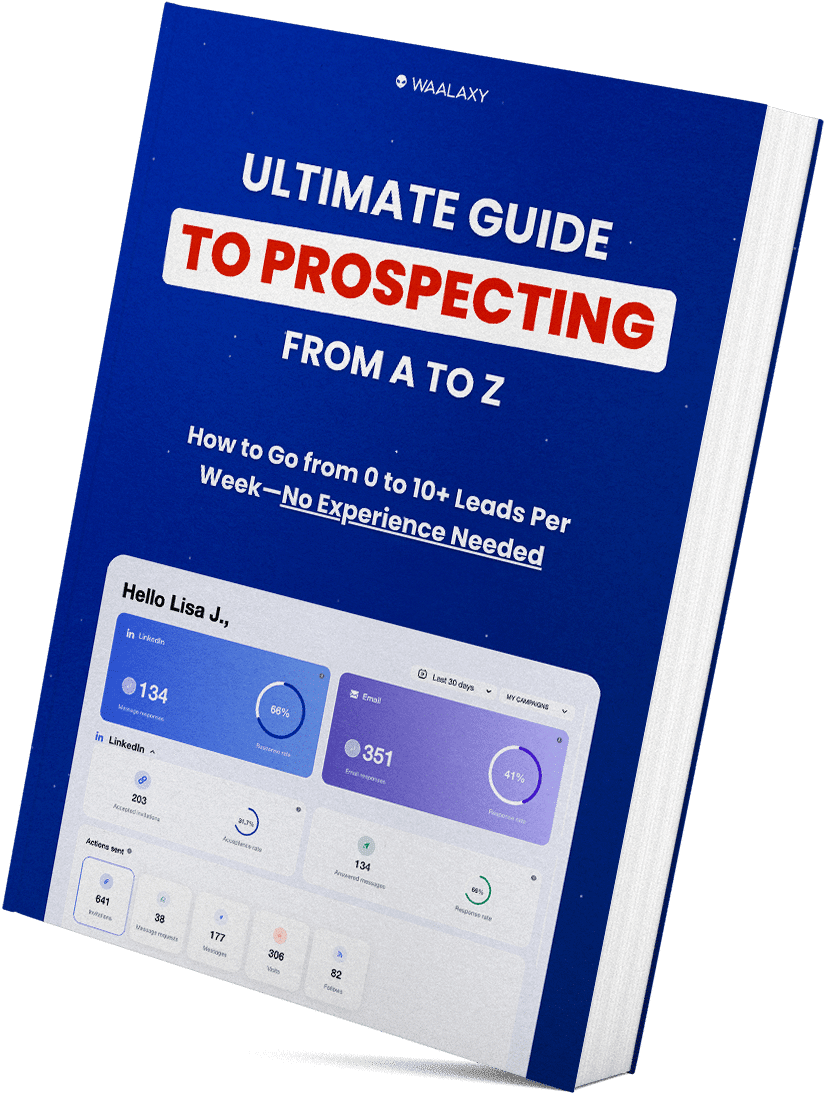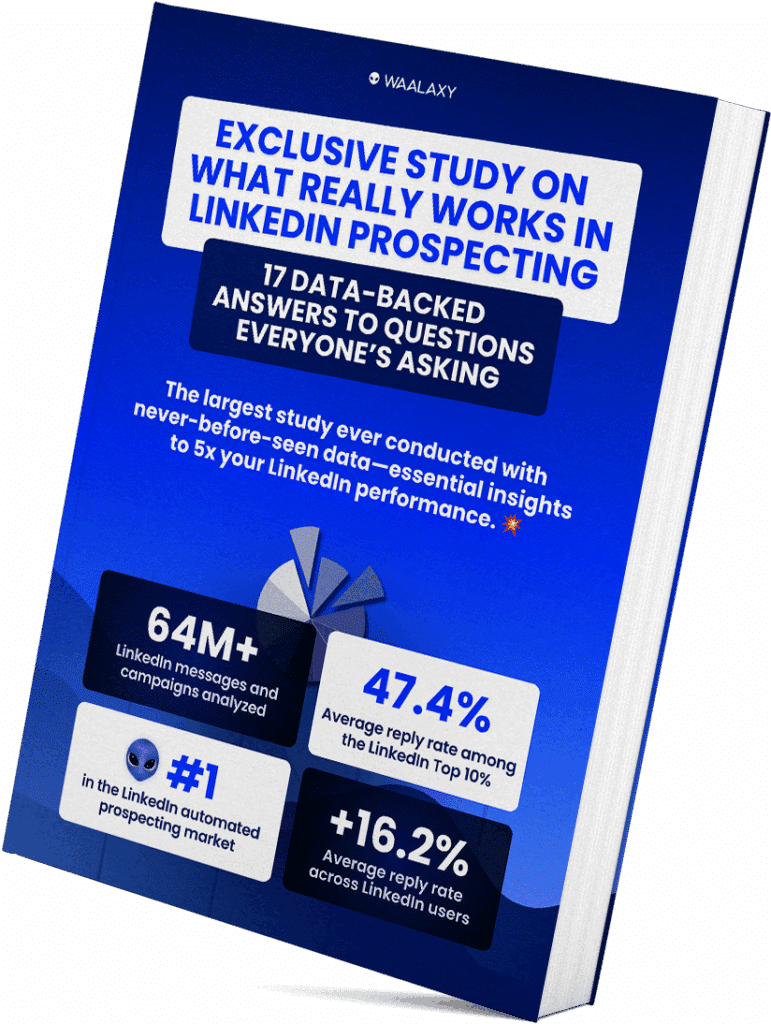Have you just launched your business, or are you about to? You’ve worked on your branding, fine-tuned your website, maybe even tested a few posts on LinkedIn… And now, the big question: “OK, but how how to get clients easily?”
Spoiler: it’s not (just) waiting for people to magically fall in love with your offer. 🙃
Today, canvassing customers isn’t just about knocking on doors or making 300 cold calls in a day. That was before. Today, it’s all about intelligent, targeted and, above all, digital prospecting. And just as well: that’s what we’re talking about today.
Canvassing definition
When we hear the word “canvass”, we often think of the cliché of the suit-wearing salesman making cold calls or going door-to-door. Spoiler: in 2025, it’s not really like that 👀
Canvassing simply means reaching out to your prospects to present your solution, even before they’ve expressed a need.
It’s a prospecting strategy, nothing more, nothing less. But today, the way we do it has changed radically.First and foremost, canvassing is a business technique 💰. When you’re in this line of business, you set up a structured marketing process to get more clients, not just random contacts. These clients are carefully targeted and qualified in advance.
The goal? Reach out to them to expand your customer base, attract every potential new client, and build lasting relationships. If you do it right, your satisfied customers will naturally become your best referral source — helping you grow faster, with trust and credibility. Ultimately, this is what we call modern prospecting.✨
BtoC vs BtoB canvassing: not to be confused
There are two main types of canvassing 👇🏻 :
- BtoC (Business to Consumer): Here, you sell to private individuals. The salesperson promotes a product or service through advertising (billboards, TV, print), but alsothrough digital channels: Google Ads, social networks, emailing…😇
- BtoB (Business to Business): Here, you’re addressing companies, and especially their decision-makers. We don’t target “” everyone, but only profiles with purchasing and decision-making power. Your message, your approach, your channels… everything changes. More substance, more personalization, more strategy 🧠
Canvassing customers ≠ Inbound
A useful reminder: canvassing is an Outbound Marketing strategy. It’s you going out to people.Inbound marketing, on the other hand, is about bringing customers to you through content, posts, SEO…
🧠 The two are complementary. But, if you’re just starting out, outbound gives you immediate leverage to test your offer, refine your messages and generate your first leads.
It’s also what allows you not to depend 100% on an algorithm or Google.
How to get clients : create your persona
Come on, we’re not going to lie: as soon as you mention persona, a lot of people roll their eyes. 😒
“Another form to fill in with a fictitious first name, an image bank photo and the words “likes walks in the forest?” No thanks.
A buyer persona is not a gimmicky marketing exercise. It’s a strategic tool to help you :
- Talk to the right person (not “everyone”).🤌🏻
- Write messages that resonate with your real issues.🧐
- Choose the right channels and avoid wasting time elsewhere.😎
- Qualify your leads and optimize your conversion rate.📈
In short, a good persona keeps you from chasing prospects who don’t care about what you offer.🏃🏻♀️
One persona = one specific segment. You can have 2 or 3! 😇
How do you create a B2B persona?
You don’t need to invent a life for your target. What counts is having useful information for prospecting. Here’s what you really need to know 👇🏻 :
1. Structural information :
- 👩🏻🏫 Position held : CEO, Head of Marketing, DRH…
- 🏠 Type of company: SME? Start-up? Major account?
- 💼 Business sector: SaaS, e-commerce, industry, construction…
- 👯 Approximate headcount and sales.
- 🌍 Geographical area if relevant.
2. Business objectives: What is this person trying to achieve? Ex: “generate more qualified leads”, “automate a time-consuming task”, “reduce recruitment costs”…
3. Friction points: What are your day-to-day problems ? Lack of time? Unsuitable tools? Processes too slow? Dependence on an agency?
4. Buying behavior :
- Is this a curious or highly rational person? ✨
- Where does she get her information (LinkedIn? Pro podcasts? Webinars?)😇
- Does she decide alone or by committee?🤓
5. Potential obstacles :
- “We don’t have a budget.”💸
- “It’s too complex to set up.”🙃
- “I have to convince my boss.”🥲
You need to anticipate these objections in your messages right from the start.
Example of a B2B persona 👇🏻 :
Julie, Marketing Director in a SaaS SME (40 people).
– Objective: automate her prospecting to save time and generate leads without recruiting.
– Pain points: too many manual tasks, dependence on a growth agency, unclear ROI.
– Favorite channels: LinkedIn, newsletters, webinars.
– Decision-maker? Yes, but must align with CEO.
– Classic objection: “I don’t have enough time to test a new tool.”
👉 With a persona like this, you can build a real sequence of messages, aligned with their needs, vocabulary and disincentives.
How to approach customers: Using social networks
Now that you’ve defined your personas, you know exactly who you want to sell to. But the crucial question is: what channels will you use to reach them effectively?
In B2B, the classic mistake is to want “to be everywhere” but in reality, too many channels kill impact. What you need are levers that are targeted, tested and adapted to your audience. And in a digitalized world, certain channels clearly stand out 🤩
In the past, a B2B salesperson could make do with an address book, a few trade shows and a phone line. Today, that would be shooting yourself in the foot.
Your prospects 👇🏻:
- Receive dozens of emails every day 😔
- Are drowning in solicitations.🫠
- Have no time to waste on empty speeches or impersonal cold calls.🥶
What they expect is fast, relevant, digital and contextualized contact. And that’s exactly what the right digital channels can offer you. Better still: you can measure every action, adjust in real time and scale what works.✨
Get new client on LinkedIn
If there’s one social network you can’t ignore when it comes to finding your first (and subsequent) customers, it’s LinkedIn.
Whether you’re a freelancer, consultant, salesperson or startup founder, LinkedIn is the ideal place for B2B prospecting, provided you know how to use it intelligently.🤓
Historically, LinkedIn was mainly used to find a job or network with former colleagues.But today, it’s an ultra-qualified business database, with millions of decision-makers, executives, technical or business profiles… that you can target for free. 😍
On LinkedIn, you can 👇🏻 :
- Identify qualified prospects🌟
- Get in touch with them without intermediaries.☎️
- Build a relationship.💞
- Offer them your service in a fluid, contextual way, without forcing it.😏
And the best part? You don’t need an advertising budget to get started. What counts is having a clear method and a good message. 🤗
Step 1: Do your research
It all starts here: Doing a good LinkedIn search. Type in a strategic keyword 👇🏻 :
- 💼 The position you’re targeting (e.g. “Marketing Manager”, “CEO”, “Office Manager”).
- 🙂↕️ The name of a company if you’re targeting a specific sector.
- 👩🏻🏫 The name of a prospect if you already know who you’re looking for.
- 📚 S pecific topics (“prospecting”, “CRM software”) to see who’s talking about it or interested in it.
➡️ Once your results are displayed, think about refining them with the filters (location, current company, sector, hierarchical level…).
Step 2: Send a connection request
Now that you’ve identified an interesting prospect, it’s time to get in touch.
The golden rule here 👇🏻:
🎯 Give preference to requests without a note (they have a higher acceptance rate).
Why? Because they’re more natural, less perceived as commercial.
But, if you have a well-written, hyper-personalized approach, with a real value angle (e.g. “I read your post on cross selling, I thought it was super relevant because…”), then feel free to leave a note. 😎
The goal is not to sell right away, but to spark a conversation.💬
Step 3: Start the exchange tactfully
Once you’ve accepted the connection, don’t jump straight into your pitch.
Start with a short, human message focused on your prospect:
- Make reference to what made you want to contact him.👀
- Ask a question or gently bring the discussion to one of their issues.✨
- Show that you’re there to help, you need to bring value, not to sell at any price.🏆
👉 Example:
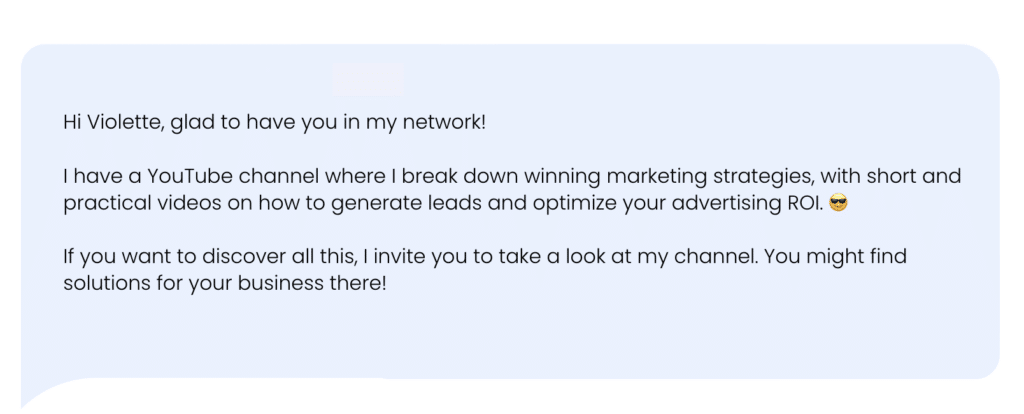
Step 4: Boost your visibility with your content
Networking is all very well. But, if you want your prospects to think of you when they have a need, you need to stay visible. And that means useful content, posted regularly on LinkedIn.😍
Here’s what works:
- Concrete advice related to your expertise (checklists, mistakes to avoid, tips).✅
- Intelligent comments under your prospects’ posts: it nurtures the relationship.😏
- Sharing customer experiences (keeping it factual, without overdoing it).🤩
- Answers to your target’s frequently asked questions (in the form of a post, carousel, video…).🤓
📈 Result? When you follow up with a prospect, they’ve already seen you in their feed.
You’re no longer a stranger: you become a credible reference. And that changes everything.
To help you find potential customers on LinkedIn, we’ve got a little extra solution for you: Waalaxy. 😎
How do I find new customers with Waalaxy?
If you haven’t heard of Waalaxy yet, get ready to discover one of the best allies for your prospecting on LinkedIn.😚
Imagine: a tool that helps you send invitations, follow-up with prospects, automate your messages… without needing to be a tech expert or spend your evenings there.🤯
Waalaxy is a small, super-lightweight, yet ultra-powerful Chrome extension. It lets you launch your LinkedIn campaigns in just a few clicks, save an incredible amount of time, and above all: generate leads regularly, even while you’re working on something else.🥳
In concrete terms, Waalaxy lets you 👇🏻:
- Find and contact your prospects on LinkedIn.🤗
- Develop your network in a targeted way.🎯
- Use automated “invitation +” message sequences.📨
- Automatically follow-up with people who haven’t responded.🗣️
- A/B testing for multiple messages.🌟
You can contact up to 100 people a week, in less than 10 minutes a day, for free (with the basic plan). It’s simple, effective, and perfect for kick-starting prospecting.😮💨
Approach new client on LinkedIn: Example
Once you’ve installed Waalaxy, simply click on the extension and open a LinkedIn page. Once you’re there, we’ll start looking for customers. In our case, we’ve decided to target all Fullstack developers in France to sell them a billing service. Here are the next steps 👇🏻 :
1. In the LinkedIn search bar, type the keyword “CEO”.
Double-click on the magnifying glass 🔍 to force results to be displayed in full.
2. Refine results:
- Click on “People”.🧍🏻♀️
- Use advanced filters to target France only, or other criteria: industry sector, company size…🎯
- You can also filter by specific keywords: “SaaS”, “JavaScript”, or a title like “Fullstack Developer” if your target changes.🙃
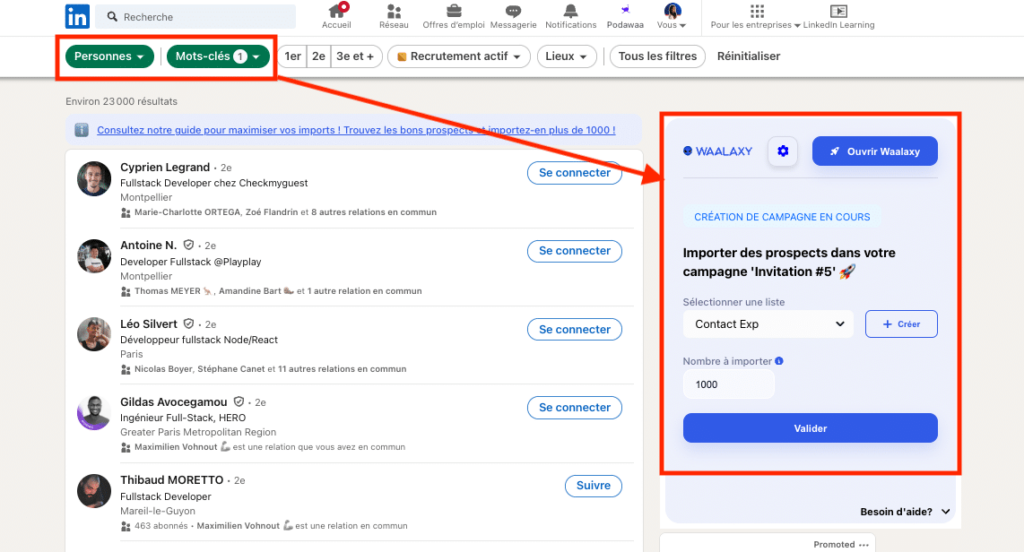
3. Once your list is clean, click on “Import with Waalaxy”.
The profiles are added directly to your prospect list in the tool.
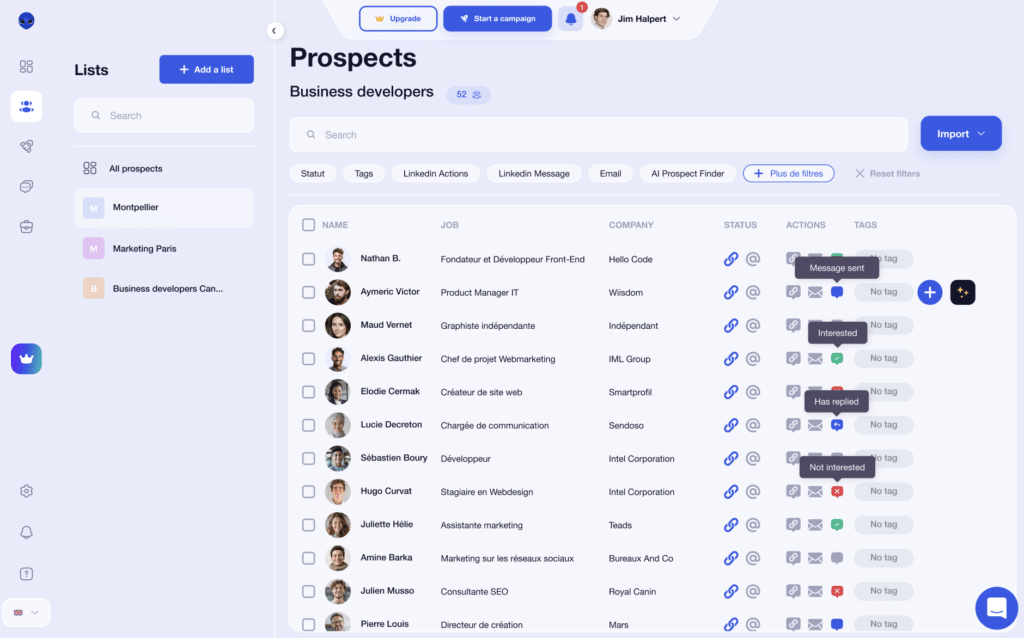
From now on, you will 👇🏻:
- Import your leads (you can choose your number of imports) and click on “confirm”.🤓
- Then start a campaign. We advise you to choose the campaign: “Visit + Invitation + message”.✨
- Name your campaign if you wish (it’s always better if you want to find your way around).🙂↕️
- Then choose your list.👀
- Choose the time between the visit and the next action.⌛️
- Send your invitation without a note 📩.
- Set up the delay after the invitation.⌛️
- Write your prospecting message with the help of Waami.📝
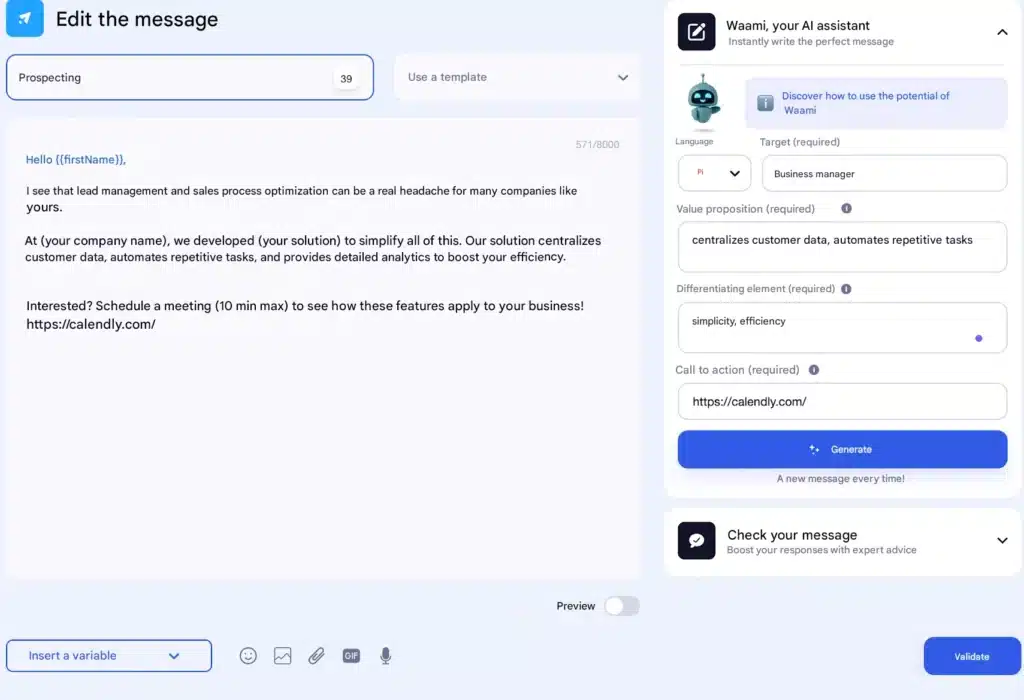
- Click on “Validate” and launch your campaign ✅
Thanks to what we’ve just shown you, you can now start acquiring new customers, canvassing them and sending them the right message. 🥳
How do you approach a company?
In B2B, you don’t have 50 opportunities to make a good impression. So it’s best to go about it methodically. Here are the 4 steps you need to follow to approach a company strategically and effectively. 🚀
#1 Gather the right information
Just like a persona, you need to know who you’re targeting and what their issues are. You’ll need to know :
- 🕺🏼 Who the decision-makers are (CEO, CTO, Head of Sales…)
- ☎️ How to contact them your prospects? (LinkedIn, email, via a common contact?)
- 👀 What are their real current needs?
- 😓 What are their concrete pain points?
This is a vital step that shouldn’t be overlooked, since it will not only enable you to retrieve data, but also to be able to answer any queries coming from the company’s side. The more relevant you are, the more answers you’ll get. 😏
#2 Get in touch with your prospects
In this phase of prospecting, you’ll need to get in touch with the company in question. But we’re talking mainly about decision-makers here: you’ll need to start contacting the company’s decision-makers 🤓
This means you’ll need to know who makes the decisions in the company and what their preferred means of communication is 💓. You’ll have the choice of approaching them by :
- Mailing.💌
- LinkedIn.📲
- Phone.📞
🚨 Please note: don’t send a pamphlet or recite your sales pitch.
What you need to do is 👇🏻:
- Grab attention from the very first sentence.✨
- Show that you understand their context.😎
- Propose a short, solution-oriented exchange(“How about we discuss this for 15 minutes?”).⏰
🎯 The idea is to lay the foundations for a relationship, not to sell from the very first message.
This is a decisive step, since making contact with your prospect will enable you to lay the foundations and then explain your product or service. Don’t hesitate to ask them questions to find out about their obstacles and motivations.💪🏻
#3 Drawing up a sales proposal
Once the first contact has been made, the discussion has got off to a good start and your prospect has shown some interest, it’s time to move on to the next stage: the sales proposal. But there’s no need to pull out the big 40-page PDF file or a lengthy PowerPoint 🥲
What’s a sales proposal?
Quite simply, it’s a synthetic document that summarizes what you’re offering, to whom, why, how and at what price. It’s intended for a decision-maker or someone on their team — often a business owner — who will have to justify the choice of your solution 🤓
In short, it’s your offer, but with a very specific objective: to convince by putting yourself in the customer’s shoes.😎
👉 A good sales proposal must be :
- Clear and readable (1-3 pages are more than enough).
- Focused on your prospect’s problem, not on you.
- Illustrated with your solution and its concrete benefits (time savings, cost savings, performance gains, etc.).
- Accompanied by a simple, reassuring action plan.
- Transparent pricing and terms and conditions and why not include a limited-time discount to create urgency?
And don’t forget: if your goal is to attract new prospects consistently, make sure each proposal reflects your understanding of their pain points and motivations.
Add a customer example, testimonial or case study to lend credibility to your solution. There’s nothing like concrete evidence to reassure a decision-maker. 😇
#4 Follow up with your prospect
Once you’ve sent your sales proposal, don’t expect an immediate “yes”. And that’s completely normal. 👌🏼 A decision-maker often needs time to think, compare and discuss internally. But that doesn’t mean you should leave him in silence for weeks on end 📆
Let a little time pass first (2 to 5 days, depending on the context). Then get back to him in a simple way. A good follow-up e-mail, for example, isn’t just a “Hello, have you had a chance to read my proposal?” It’s a real opportunity to create value, engage in discussion, and sometimes even… unblock a project. 🤩
For example:
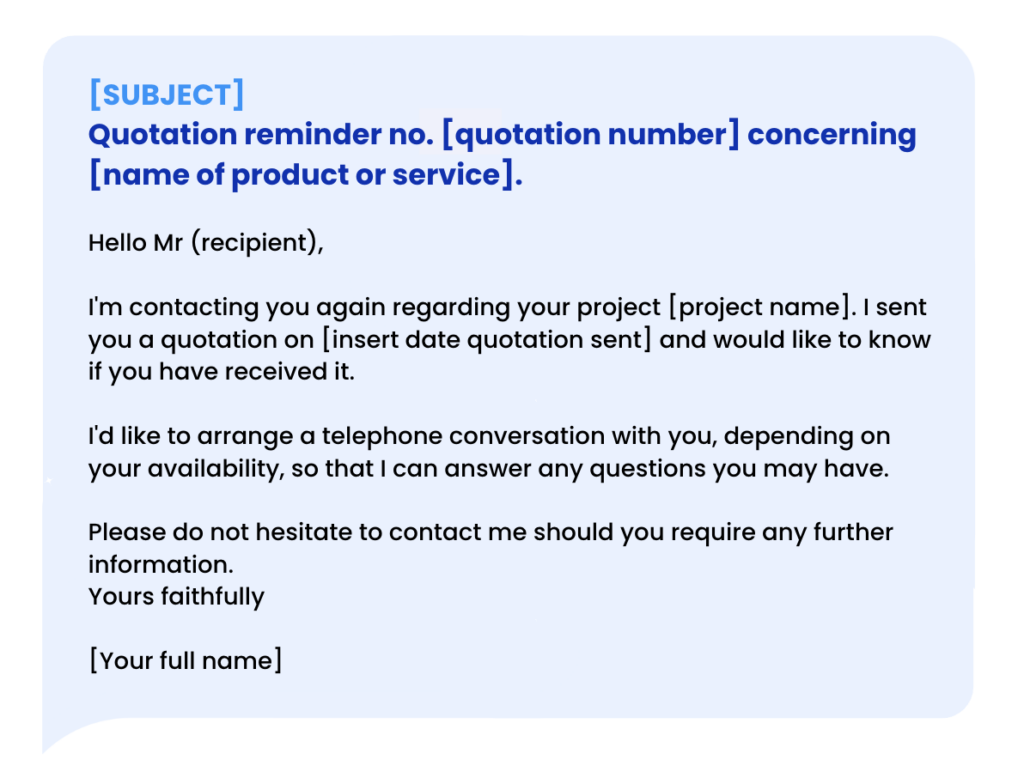
This is often the real starting point for a serious discussion. It’s the moment when the prospect asks you his real questions, when you identify his doubts, hang-ups and objections.🤗
In short: be present, without pressure. Proactive, but not insistent. Show him that he can count on you, even before signing.✍🏼
Let’s have a recap: How to get clients easily ?
As you’ve seen, prospecting is no longer a matter of making empty calls or sending impersonal e-mails. Today, B2B prospecting is all about a targeted, digital strategy — one of the smartest ways to get in touch with both potential clients and current customers to offer real value. 🌟
➡️ To sum up:
🎯 You start by knowing your target well.
🔎 You choose the right channels: LinkedIn, email, automation.
💬 You start the conversation.
📄 You propose a clear, customer-oriented solution.
🔁 You follow up with intelligence, without insistence.
With the right tools like Waalaxy and a true needs-oriented approach, you’re no longer a salesman… you become a partner. ✨
Frequently asked questions
How do I know if my target is really qualified before contacting them?
That’s the big question for anyone starting out in prospecting: how many messages does it take to get new leads?
Is it true? There’s no universal rule. But, in general, it takes between 2 and 4 messages to get new clients, especially in B2B.
Why so many? Because your prospects 👇🏻 :
- are often highly solicited.😢
- don’t know you yet.😩
- need time to identify the real interest of your approach.🙃
👉 What counts is not just the number, but the quality of each message:
- The first serves to capture attention.
- The second relaunches with value (e.g.: white paper, insight, SEO strategy tip, customer testimonial…).
- The third can ask a simple question or suggest a time slot.
Above all, avoid copy-and-paste messages. Adapt to each persona, each case. Personalization and relevance are always better than repetition. 🔁
Now you know all about how to canvass customers! 🚀


